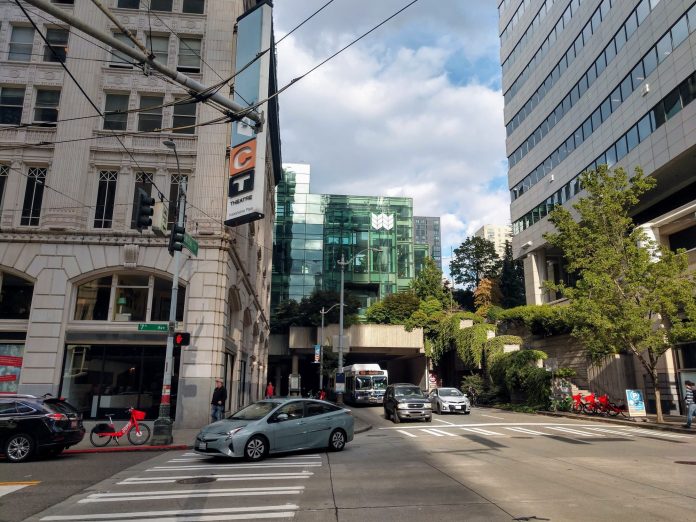Mayor Jenny Durkan’s plan to tax Uber and Lyft rides in Seattle lacks a coherent understanding of the problem posed by the explosion of ride-hailing trips. The two primary problems posed are the companies’ exploitation of their drivers and their outsized impact on transit and congestion in our major cities, including Seattle.
The Mayor’s plan attempts to address the first problem by setting minimum pay rates for drivers. While this is not the only issue with how the companies treat their workers, it is a step in the right direction, even if it excludes similarly structured food delivery companies.
With that said, the plan ignores how Uber and Lyft contribute to congestion in Seattle, and enacting the tax as is will be unnecessarily regressive and largely ineffective. For starters, ridehailing is only viable (albeit semi-viable) in dense, urban areas; in other words, the parts of the city where transit works best. It follows that most of the projected growth in ridehailing will be in these areas, where it can be profitable. This, combined with the tax’s structure, could lead to a devastating catch-22: either we curb ridehailing use and we lose funding for transit projects (goodbye, streetcar!) or we allow ridehailing to grow and transit suffers due to congestion.
Really it’s a collision course: 25 million dollars a year for transit is peanuts if the number of ridehailing rides increases from 28 million this year to 49 million, as the revenue estimates imply (or 33 million trips, if you use the entire 75-cent total tax number in your calculations, ignoring obligations to administration overhead and supporting wheelchair accessible vehicles via the existing 24-cent fee). Having more buses on the roads doesn’t help if the roads are even more congested. Unfortunately, the Mayor sees 49 million trips as a larger tax base rather than the problem needing a solution. In short, a flat 51-cent tax will not provide the change we seek.
A flat tax also has a regressive incidence. People with low incomes will pay a greater portion of their income, even if wealthier people are generally using the service far more. This is exacerbated by the fact white collar workers are much more likely to get their ridehailing trips comped by their employers. In a city and state that already have an extremely regressive tax code, we should do everything in our power to make new tax sources as progressive as possible. We also need to recognize that not everyone has a job that allows them to be a little late if the bus doesn’t show, which makes an occasional Uber and Lyft important for job security.
Enter the variable ride-hailing tax, a tax that varies based on the available transit options between the relevant point A and point B. The tax rate would be a function of the applicable transit frequency, time of day, and trip time relative to the trip time by car. For example, if a person wants to take an Uber from Husky Stadium to Capitol Hill during rush hour, they would be assessed at the highest rate, something much higher than 51 cents. Given that taking Link would be quicker, cheaper, and less harmful to society, the person choosing to take an Uber should compensate for the externalities they generate by paying the steepest tax. On the other side of the equation, trips where there is no reasonable transit alternative may not incur any tax or a considerably lower one.
While designing the tax would take some work, in essence it would be no more difficult than having a program that inputs a destination and origin into Google Maps to get a transit trip time and then plugs that number into an algorithm that returns a tax rate. Trips that require multiple transfers could have a lower rate than one-seat rides, and certain areas that are particularly snarled with congestion, like Mercer or Denny, could have a special surcharge. The City should also require that the Uber and Lyft apps show which transit option the rider is being taxed against to nudge them towards it. Ditto Google Maps and other mapping apps.
This tax structure will improve our transit system in two distinct ways. First, the tax itself would be a strong and clear incentive to take transit, reducing congestion from the now displaced ridehailing trips. Second, the revenues from the tax should be used to fund transit improvements that make service more reliable and convenient. We could build sidewalks, bike lanes, bus lanes, or literally do anything that would give people better options. This would cut down on late and full buses that generate emergency ridehailing trips and provide everyone in the city with more freedom of movement.
To be fair, Mayor Durkan’s plan does call for investments in transit and housing, but it ignores the ability of taxes to discourage unwanted behaviors, opting for a carrot-heavy strategy that will likely be ineffective.
By placing the tax on those who have the most options, we can limit the burden on those who have the least. We don’t live in a city where it’s practical to get everywhere without a car. Putting a small flat tax on ridehailing will harm low-income people who need the services without curbing the excessive and harmful use by the rich.
However, we are lucky enough to live in a city where you can get to a lot of places without a car, and we shouldn’t allow people (like a certain D4 council candidate) to convince us that that isn’t the case. So let’s tax people who could easily get on the bus while supporting transit riders throughout the city with an equitable variable tax.
We are in the midst of our fall subscriber drive. Please consider becoming a monthly donor. Thanks!

Kyle Berquist (Guest Contributor)
Kyle Berquist is a recent college graduate, studying environmental policy with a focus on urban planning. Growing up in Shoreline, he never visited Seattle without a car, but now you’ll find him waiting patiently for the 12 (and Madison BRT) or slogging it up the hill on his bike.

